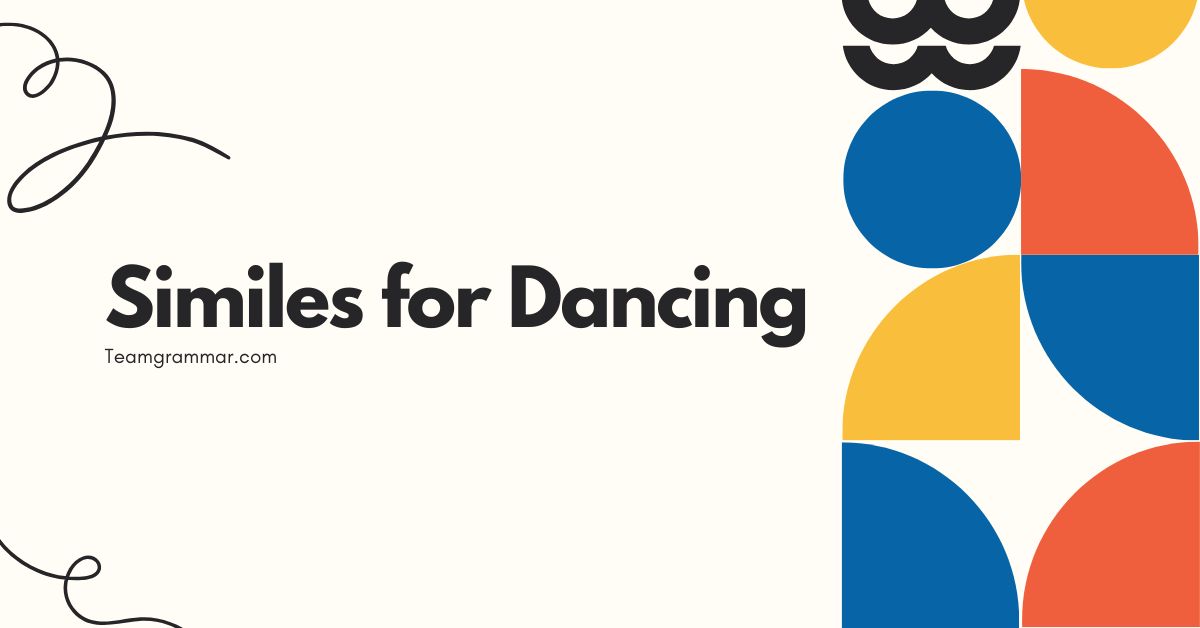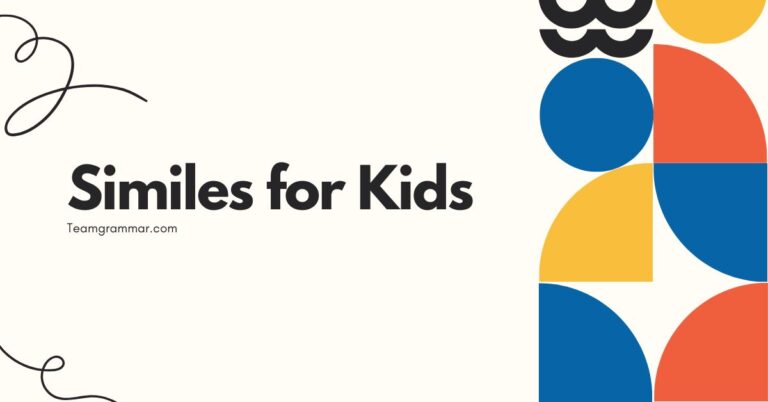49 Similes for Dancing: Enhancing Your Descriptive Language
Understanding similes is crucial for enriching your vocabulary and descriptive abilities, especially when writing or speaking about expressive activities like dancing. Similes, by comparing one thing to another using “like” or “as,” allow you to paint vivid pictures with words, making your descriptions more engaging and imaginative.
This article benefits students, writers, dance enthusiasts, and anyone aiming to improve their command of the English language through creative expression.
Table of Contents
- Introduction
- Definition of Similes
- Structural Breakdown of Similes
- Types of Dance Similes
- Examples of Similes for Dancing
- Usage Rules for Similes
- Common Mistakes with Similes
- Practice Exercises
- Advanced Topics in Similes
- Frequently Asked Questions
- Conclusion
Definition of Similes
A simile is a figure of speech that compares two unlike things using the words “like” or “as.” The purpose of a simile is to create a vivid image, emphasize a particular quality, or make a description more relatable by drawing a comparison to something familiar. Similes are a fundamental tool in descriptive writing and speech, allowing for more nuanced and imaginative expression.
They enhance understanding and appreciation by linking the unfamiliar to the familiar.
Similes are classified as a type of figurative language, specifically under the umbrella of comparisons. They function to illustrate, clarify, and embellish descriptions.
The context in which a simile is used can range from everyday conversations to sophisticated literary works, making them versatile tools for communication. Similes can evoke emotions, create humor, or deepen the reader’s understanding of the subject being described.
Structural Breakdown of Similes
The basic structure of a simile consists of three components: thesubjectbeing described, thelinking word(“like” or “as”), and theobjectto which the subject is being compared. Understanding this structure is essential for creating effective and grammatically correct similes.
The subject and object are typically nouns or noun phrases, while the linking word establishes the comparison. The structure provides a framework for creative expression.
For example, in the simile “She dances like the wind,” “she” is the subject, “dances” is a verb describing the action, “like” is the linking word, and “the wind” is the object of comparison. This structure clearly conveys the fluidity and grace of her dancing.
Similarly, in “He moves as smoothly as silk,” “he” is the subject, “moves” is the verb describing the action, “as” is the linking word, and “silk” is the object of comparison, highlighting the dancer’s smoothness. The linking word is crucial for indicating that it is a comparison and not an equivalence.
Types of Dance Similes
Similes for dancing can be categorized based on the aspect of dance they emphasize, such as movement, emotion, or appearance. By understanding these categories, you can create more specific and impactful comparisons.
Each category offers a different lens through which to view and describe the art of dance. The categories are not mutually exclusive; a simile can often fit into multiple categories.
Similes Describing Movement
These similes focus on the physical aspects of dancing, such as the speed, fluidity, or precision of the movements. Examples include “He leapt like a gazelle” (emphasizing agility) and “She flowed across the floor like water” (emphasizing fluidity).
These types of similes often use action verbs and vivid imagery to convey the dynamism of the dance.
Similes Describing Emotion
These similes aim to capture the feeling or mood conveyed through the dance. For example, “They danced as if their hearts were on fire” (emphasizing passion) and “She moved like a shadow, expressing sorrow” (emphasizing sadness).
These similes often use emotional metaphors to create a connection with the audience.
Similes Describing Appearance
These similes focus on the visual aspects of the dancer or the dance itself, such as their grace, elegance, or energy. Examples include “She shimmered like starlight on the stage” (emphasizing radiance) and “He stood as tall and proud as a king” (emphasizing posture).
These similes often use sensory details to paint a vivid picture.
Similes Describing Sound
Although less common, similes can also describe the sounds associated with dancing, such as the rhythm, the music, or the dancer’s footsteps. For instance, “The music pulsed like a heartbeat” (emphasizing rhythm) and “Her steps echoed like distant thunder” (emphasizing impact).
These similes engage the auditory sense to enhance the description.
Examples of Similes for Dancing
Below are several examples of similes used to describe different aspects of dancing, categorized by their focus. These examples illustrate the versatility and creativity that similes can bring to descriptive writing.
Each table provides a range of examples to inspire and guide your own simile creation.
Examples Describing Movement
The following table provides examples of similes that focus on the movement involved in dancing. These similes use vivid imagery to convey the speed, fluidity, and precision of the dancer’s actions.
| Simile | Emphasis |
|---|---|
| He spun like a top. | Speed and rotation |
| She glided across the floor like a swan. | Grace and smoothness |
| They moved together like gears in a machine. | Precision and coordination |
| He leaped like a gazelle. | Agility and power |
| She flowed across the floor like water. | Fluidity and grace |
| His feet moved as quickly as a hummingbird’s wings. | Speed and agility |
| She twisted like a vine. | Flexibility and grace |
| He jumped as high as a basketball player. | Height and power |
| She landed as softly as a feather. | Lightness and grace |
| He stepped as lightly as a cat. | Agility and stealth |
| She pirouetted like a ballerina in a music box. | Delicacy and precision |
| He swayed like a tree in the wind. | Fluidity and natural movement |
| She bounced like a rubber ball. | Energy and resilience |
| He dashed across the stage like a sprinter. | Speed and determination |
| She paused as still as a statue. | Poise and stillness |
| He dipped her as smoothly as melted butter. | Grace and ease |
| She rose like a phoenix from the ashes. | Triumph and rebirth |
| He stamped his feet like a thunderous drum. | Power and rhythm |
| She turned like a whirlwind. | Speed and intensity |
| He floated like a cloud. | Effortlessness and lightness |
| She spun as if gravity didn’t exist. | Freedom and weightlessness |
| He moved like a shadow, silent and swift. | Stealth and fluidity |
| She danced as if she were made of liquid moonlight. | Ethereal grace and beauty |
| He leapt with the force of a coiled spring. | Power and potential energy |
| She undulated like a serpent. | Fluidity and sinuous motion |
| He strode across the stage like a conquering hero. | Confidence and dominance |
| She glided as effortlessly as a skater on ice. | Smoothness and grace |
| He twisted and turned like a kaleidoscope of motion. | Complexity and beauty |
| She balanced as precariously as a tightrope walker. | Skill and precision |
Examples Describing Emotion
The following table provides examples of similes that focus on the emotions conveyed through dancing. These similes use emotional metaphors to create a connection with the audience and express the inner feelings of the dancers.
| Simile | Emphasis |
|---|---|
| They danced as if their hearts were on fire. | Passion and intensity |
| She moved like a shadow, expressing sorrow. | Sadness and grief |
| He danced with the joy of a child. | Happiness and innocence |
| She expressed her anger like a storm on stage. | Rage and power |
| They moved together as if bound by invisible threads of love. | Connection and affection |
| He danced with the desperation of a prisoner yearning for freedom. | Longing and desire |
| She danced like a fragile flower, expressing vulnerability. | Delicacy and sensitivity |
| He danced with the confidence of a seasoned performer. | Assurance and poise |
| She danced as if she were reliving a cherished memory. | Nostalgia and sentiment |
| He danced with the ferocity of a warrior. | Strength and aggression |
| She danced as if she were whispering secrets to the wind. | Intimacy and mystery |
| He danced with the lightness of a carefree spirit. | Joy and liberation |
| She danced as if she were trying to escape a painful past. | Struggle and resilience |
| He danced with the quiet strength of a mountain. | Resilience and stability |
| She danced as if she were embracing the world with open arms. | Acceptance and love |
| He danced with the intensity of a burning flame. | Passion and energy |
| She danced as if she were lost in a dream. | Wonder and enchantment |
| He danced with the grace of a forgiving heart. | Kindness and compassion |
| She danced as if she were painting emotions on the air. | Expression and artistry |
| He danced with the sorrow of a broken heart. | Grief and pain |
| She moved as if she were carrying the weight of the world on her shoulders. | Burden and resilience |
| He danced with the hope of a new beginning. | Optimism and renewal |
| She danced as if she were searching for something lost. | Longing and quest |
| He danced with the quiet determination of a marathon runner. | Endurance and focus |
| She danced as if she were celebrating life’s simple joys. | Gratitude and happiness |
| He danced with the vulnerability of an open book. | Honesty and transparency |
| She danced as if she were weaving a magical spell. | Enchantment and mystery |
| He danced with the strength of a thousand warriors. | Power and resilience |
| She danced as if she were speaking a language of the soul. | Expression and emotion |
Examples Describing Appearance
The following table provides examples of similes that focus on the visual aspects of the dancer or the dance itself. These similes use sensory details to paint a vivid picture of the dancer’s grace, elegance, and energy.
| Simile | Emphasis |
|---|---|
| She shimmered like starlight on the stage. | Radiance and beauty |
| He stood as tall and proud as a king. | Posture and confidence |
| Her costume sparkled like a thousand diamonds. | Brilliance and glamour |
| He moved with the elegance of a prince. | Grace and refinement |
| She looked as delicate as a porcelain doll. | Fragility and beauty |
| He was as captivating as a work of art. | Allure and beauty |
| She glowed like a radiant sunset. | Warmth and beauty |
| He was as striking as a lightning bolt. | Power and impact |
| She dressed as elegantly as a queen. | Sophistication and royalty |
| He presented himself as impeccably as a statue. | Perfection and poise |
| She moved like a vision from a dream. | Ethereal beauty and grace |
| He stood as a beacon of strength and poise. | Strength and stability |
| She twirled like a blossoming flower. | Growth and beauty |
| He appeared as striking as a supernova. | Brilliance and impact |
| She was as graceful as a willow tree swaying in the breeze. | Fluidity and elegance |
| He looked as commanding as a general leading his troops. | Authority and presence |
| She dressed as vibrantly as a tropical bird. | Color and energy |
| He presented himself as flawlessly as a sculpted masterpiece. | Perfection and artistry |
| She was as captivating as a siren’s song. | Allure and enchantment |
| He glowed like a fiery comet streaking across the sky. | Intensity and brilliance |
| She moved as fluidly as molten gold. | Smoothness and richness |
| He stood as firmly rooted as an ancient oak. | Stability and strength |
| She twirled as ethereally as a snowflake. | Delicacy and lightness |
| He appeared as bold as a lion. | Courage and dominance |
| She was as radiant as the morning sun. | Warmth and positivity |
| He looked as intense as a storm brewing on the horizon. | Power and anticipation |
| She dressed as colorfully as a rainbow. | Variety and joy |
| He presented himself as confidently as a seasoned performer. | Assurance and poise |
| She was as mesmerizing as a whirling dervish. | Energy and focus |
Usage Rules for Similes
When using similes, it’s important to ensure that the comparison is both logical and effective. The two things being compared should share a common quality that is relevant to the description.
Avoid clichés and strive for originality to make your writing more engaging. Always ensure the simile enhances rather than confuses the description.
For example, avoid comparing unrelated things that do not share any obvious characteristics.
Key Rules:
- Use “like” or “as”: These are the standard linking words for similes.
- Ensure a logical comparison: The two items being compared should share a relevant characteristic.
- Avoid clichés: Strive for originality to make your writing more impactful.
- Maintain clarity: The simile should enhance understanding, not create confusion.
- Consider the context: The appropriateness of a simile depends on the tone and style of the writing.
Common Mistakes with Similes
One common mistake is confusing similes with metaphors. While both are figures of speech that make comparisons, similes use “like” or “as,” whereas metaphors state that one thing *is* another.
Another common mistake is using clichés, which can make your writing sound unoriginal and uninspired. Always strive for fresh and creative comparisons.
A simile should enhance understanding, not create confusion, so avoid comparisons that are too obscure or illogical.
| Incorrect | Correct | Explanation |
|---|---|---|
| She is a rose. | She is like a rose. | The first sentence is a metaphor; the second is a simile. |
| He is as strong as an ox. | He is as strong as a weightlifter. | “As strong as an ox” is a cliché; the second simile is more original in the context of dancing. |
| He danced like a television. | He danced like a puppet on strings. | The first comparison is illogical; the second is more relevant to dancing. |
Practice Exercises
Test your understanding of similes with the following exercises. Each exercise focuses on a different aspect of simile usage, from identifying similes to creating your own.
These exercises will help you refine your skills and become more confident in using similes in your writing.
Exercise 1: Identifying Similes
Identify the similes in the following sentences.
- She moved like a whisper across the stage.
- He is a lion in battle.
- The music flowed as smoothly as silk.
- Her eyes were bright stars.
- He danced with the grace of a swan.
- The room was as cold as ice.
- Time is a thief.
- She sings like an angel.
- The city was like a jungle.
- He is as stubborn as a mule.
Answers:
- like a whisper
- (Metaphor)
- as smoothly as silk
- (Metaphor)
- with the grace of a swan
- as cold as ice
- (Metaphor)
- like an angel
- like a jungle
- as stubborn as a mule
Exercise 2: Completing Similes
Complete the following similes with appropriate endings.
- He danced as if he were…
- She moved like…
- The music was as loud as…
- His footsteps were as heavy as…
- She was as light as…
- He was as still as…
- The stage was as bright as…
- Her voice was as clear as…
- The crowd roared like…
- He spun as fast as…
Possible Answers:
- He danced as if he were floating on air.
- She moved like a shadow.
- The music was as loud as thunder.
- His footsteps were as heavy as an elephant’s.
- She was as light as a feather.
- He was as still as a statue.
- The stage was as bright as the sun.
- Her voice was as clear as a bell.
- The crowd roared like a lion.
- He spun as fast as a top.
Exercise 3: Creating Similes
Create your own similes to describe the following aspects of dancing.
- The dancer’s energy
- The dancer’s grace
- The dancer’s strength
- The dancer’s emotion
- The dancer’s costume
- The music’s rhythm
- The stage lighting
- The audience’s reaction
- The dancer’s focus
- The dancer’s passion
Possible Answers:
- The dancer’s energy was like a lightning strike.
- The dancer’s grace was like a swan gliding on water.
- The dancer’s strength was like a steel beam.
- The dancer’s emotion was like a raw nerve.
- The dancer’s costume sparkled like a galaxy.
- The music’s rhythm pulsed like a heartbeat.
- The stage lighting was as warm as a summer sunset.
- The audience’s reaction was like a tidal wave.
- The dancer’s focus was as sharp as a laser beam.
- The dancer’s passion burned like a wildfire.
Advanced Topics in Similes
For advanced learners, exploring the use of extended similes and the interplay between similes and other figures of speech can add depth to their writing. An extended simile develops a comparison over several sentences or even paragraphs, creating a more elaborate and detailed image.
Understanding how similes interact with metaphors, personification, and other literary devices can elevate your writing to a more sophisticated level. Exploring cultural and historical contexts of similes can also provide a richer understanding of their use and impact.
Using similes effectively involves understanding the subtleties of language and the nuances of comparison. Experimenting with unconventional comparisons and pushing the boundaries of traditional simile usage can lead to unique and impactful writing.
Additionally, analyzing the works of master writers to see how they employ similes can provide valuable insights. Consider how different cultural contexts might influence the interpretation and effectiveness of similes.
Frequently Asked Questions
- What is the difference between a simile and a metaphor?
A simile compares two things using “like” or “as,” while a metaphor states that one thing *is* another. For example, “She is like a rose” (simile) versus “She is a rose” (metaphor). Similes make an explicit comparison, whereas metaphors imply a comparison.
- Why are similes important in writing?
Similes enhance descriptive writing by creating vivid images and making descriptions more relatable. They allow writers to express complex ideas in a way that is easier for readers to understand and visualize, adding depth and richness to the text.
- How can I avoid using clichés in my similes?
To avoid clichés, strive for originality by thinking beyond common comparisons. Consider unique qualities of the subject you are describing and look for less obvious but equally fitting comparisons. Brainstorming and using a thesaurus can help you find fresh and creative alternatives.
- Can a simile be too complex?
Yes, a simile can be too complex if it becomes confusing or obscures the meaning of the description. The goal of a simile is to enhance understanding, so it should be clear and relevant to the context. Avoid comparisons that are too abstract or require specialized knowledge to understand.
- How do I choose the right object for my simile?
Choose an object that shares a relevant quality with the subject you are describing. Consider the specific aspect you want to emphasize and select an object that embodies that quality. For example, if you want to emphasize grace, you might compare the subject to a swan or a flowing river.
- Are similes only used in creative writing?
No, similes can be used in various forms of writing, including descriptive essays, speeches, and even technical writing. While they are more common in creative writing, they can also be used to clarify complex concepts or make technical information more accessible in other contexts.
- What is an extended simile?
An extended simile is a simile that is developed over several sentences or paragraphs, providing a more detailed and elaborate comparison. It allows writers to explore the similarities between two things in greater depth, creating a richer and more immersive reading experience.
- How can I improve my ability to create effective similes?
Practice regularly and pay attention to the similes used by other writers. Read widely and analyze how different authors use similes to create vivid descriptions. Experiment with different comparisons and ask for feedback on your writing to refine your skills.
- Can similes be culturally specific?
Yes, similes can be culturally specific, meaning that their effectiveness can depend on the reader’s cultural background and understanding. A simile that resonates with one culture may not have the same impact on another. When writing for a diverse audience, it’s important to consider cultural differences and choose comparisons that are widely understood or provide context to ensure clarity.
- Is it okay to mix similes with other figures of speech?
Absolutely! Mixing similes with other figures of speech like metaphors, personification, and hyperbole can create a richer and more layered effect in your writing. The key is to ensure that the different figures of speech complement each other and enhance the overall message, rather than creating confusion or dissonance. Experiment with different combinations to find what works best for your style and purpose.
Conclusion
Similes are powerful tools for enhancing descriptive writing and making your language more engaging and vivid. By understanding the structure, types, and usage rules of similes, you can effectively use them to paint pictures with words and create a deeper connection with your audience.
Remember to avoid clichés, strive for originality, and ensure that your comparisons are both logical and relevant. With practice and attention to detail, you can master the art of using similes to elevate your writing and express yourself more creatively.
Continue to explore different ways to use similes in your writing and pay attention to how other writers use them effectively. Experiment with different types of comparisons and don’t be afraid to take risks and try new things.
The more you practice, the more confident and skilled you will become in using similes to enrich your writing and express yourself with greater clarity and impact. Keep learning and keep creating!







